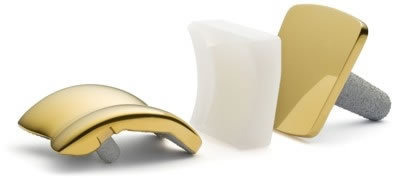in Foot and Ankle Surgery and Reconstruction
The ankle joint is the joint at the bottom of your shin bones (tibia and fibula) and the start of your foot bones (the talus bone). Where the bones meet, the bone is covered by a smooth cartilage lining of the joint, allowing you to move the ankle normally. In people who have, for example, severe osteoarthritis, rheumatoid arthritis or possibly a previous injury or fracture of the ankle, the cartilage in your ankle joint gets damaged and gradually the space in your joint then becomes narrowed with bone on bone contact causing pain and stiffness and in some cases a deformity of the ankle develops.

An ankle replacement is performed to remove the damaged joint lining as described above and replace it with metal components. The metal components are firmly adherent to the bones in the ankle (tibia and talus) and then move on one another with a highly specialised piece of plastic inside the joint.
Generally 1-2 nights hospital stay is required. The operation is done under a general anaesthesia and an added injection in the leg to numb the foot for after surgery. The operation itself can vary but in general will involve 1 incision on your ankle. The procedure involves carefully removing the damaged arthritic joint surfaces that are then replaced with metal components that adhere to the remaining bone surface. Dissolvable skin stitches are used.
Your foot will be in a plaster cast to the knee, numb and pain-free. You will see a physiotherapist who will advise on walking non-weight bearing. You will be discharged only when comfortable with an appointment and pain-killers as required.
Your physiotherapist will guide you through the stages of rehabilitation including gait re-education, swelling reduction and reducing muscle tightness. It is important to adhere to advice given.
Keep the plaster cast totally dry. You may shower with a waterproof cover over the plaster. Once the plaster is removed you may shower if the wound is healed by carefully removing the boot and gently dab the wound dry.
Once out of cast, do not pull at scabs but let them fall away naturally. If your wound becomes red, swollen or sore you need to see your Consultant to ensure there is no infection present. Your physiotherapist may advise on wound massage when its healed.
DVLA states it is the responsibility of the driver to ensure they are always in control of the vehicle. A good guide is if you can stamp down hard with the foot to stop the car in an emergency stop. This will take at least 6 weeks. Click here to read DVLA guidance.
This is very individual and job-dependent. Below is a guide:
Excellent pain relief within the first few weeks. Good function on walking and activity will build up from the 4 week stage and improve up to 12 months. Some swelling may remain in your foot and ankle for 6-12 months following surgery. Your walking should be markedly improved and people generally are very, very happy and can still perform many physical activities. You may improve your range of movement in the ankle. Good outcomes are expected in 85-90% of patients to continue up to 10-15 years from surgery.
Any operation carries a risk. Below is a guide to some risks potentially encountered. It is the surgeons duty to fully inform you of possible risks. Mr Roche will ensure this is always done so patients can make safe and informed choices about their operation.
Like any artificial implant it can loosen. Hip and knee replacements are currently more reliable than ankle replacements. Where there is plenty of studies showing hips and knees lasting 20 years or more, ankle replacement outcome has generally not been studied long enough. Around 15% may need re-do surgery after 10-15 years.
Fortunately quite rare (<2%) but can potentially be a difficult problem to treat if deep inside the ankle joint that will need further surgery, possibly to fuse the joint. Your surgeon should advise on this before the surgery.
Nerves that supply sensation to the skin are near the incision site. Damage is rare (<5%) but if your toe stays numb after surgery, the nerve may be bruised. If so it usually recovers.
Although the operation is designed to retain movement, some patients may not regain all movement. Physiotherapy can assist with this.
Continued mild discomfort is not uncommon (occurs in around 30%), however the level of discomfort is usually very mild and much less than before surgery.
Symptomatic clot formation in the leg is unusual after ankle replacement surgery (<5%). You may be given blood-thinning medication after the surgery if the surgeon deems necessary, if you are particularly at risk of clots.
This document is only meant to be a guideline to help you understand your treatment and what to expect. Every person is different and your rehabilitation may be quicker and slower. This will be advised and guided by your doctor and physiotherapist.